#16th c. France
Text
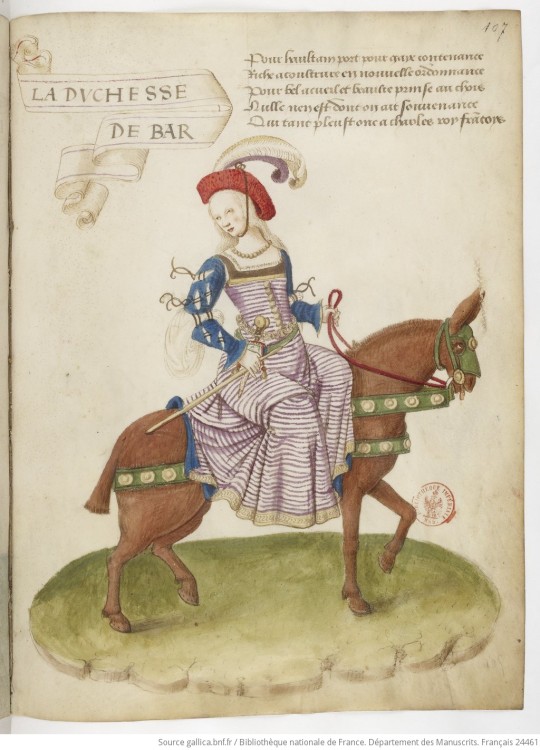


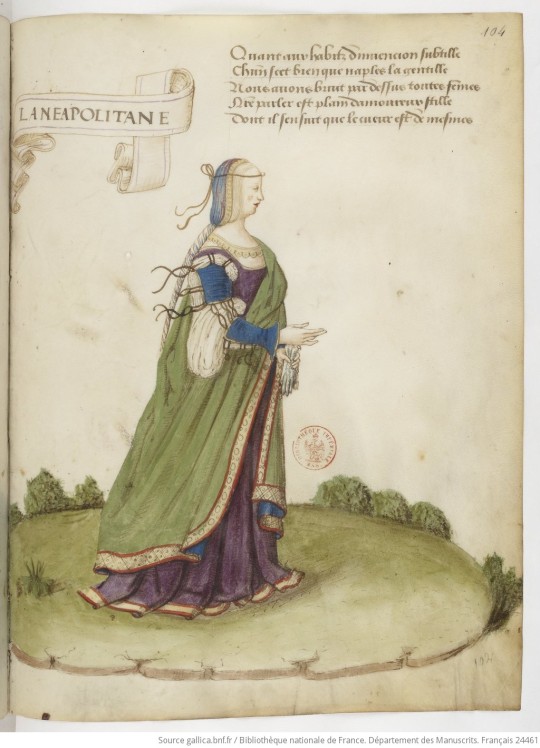


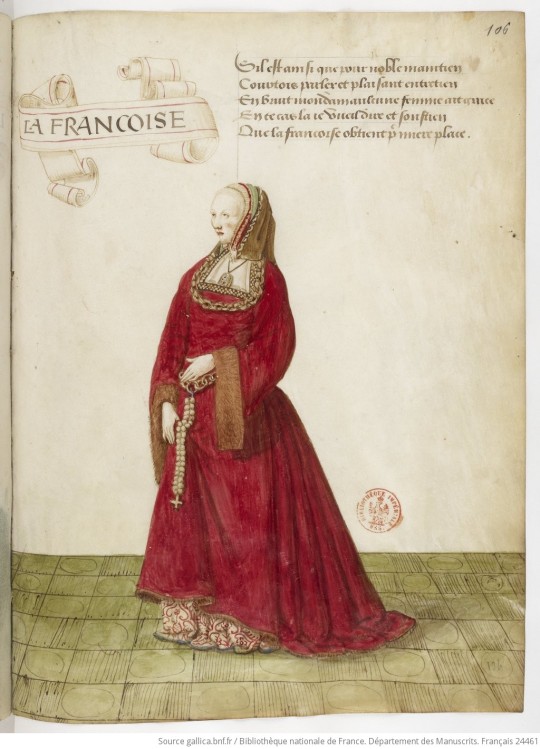


Collection of drawings accompanied by texts, known as Recueil Robertet, 1490-1520 France;
The Duchess of Bar
Women from Lombardy and Venice
Women from Naples and Florence
Women from Germany and France
Green and Yellow; White and Blue
#late 15th century#early 16th century#renaissance#manuscript#illuminated manuscript#illustrated manuscript#16th century#15th century#mdp16th c.#mdp15th c.#France#15th c. France#16th c. France#italy#costume illustration#illustration#15th c. italy#16th c. Italy#costume book#German Style#Germany#15th c. Germany#16th c. Germany#horseback#riding
131 notes
·
View notes
Text


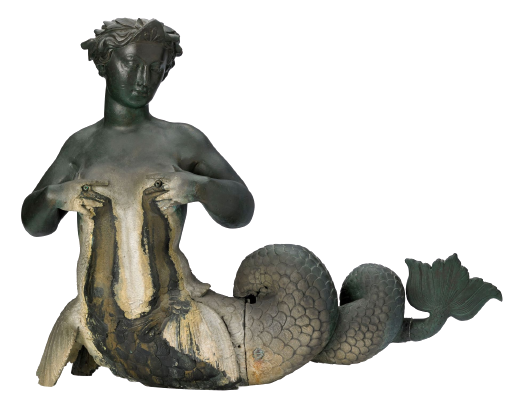



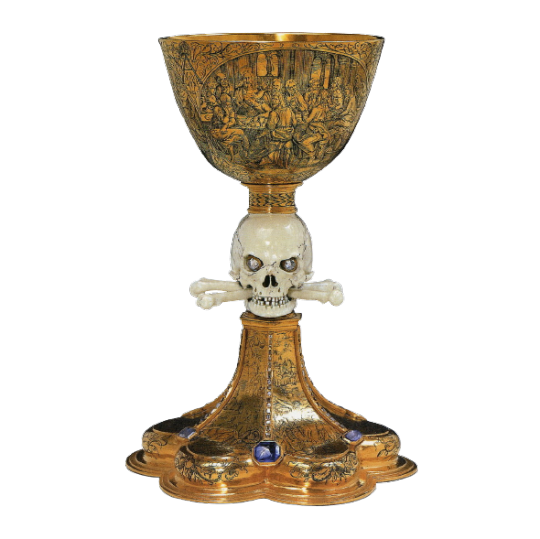


Pirate-themed PNGs, part 2.
(1. Bag of jewels, 2. Shipwreck treasure, 3. Bronze siren from 16th c. France, 4. Green glass bottle, 5. Skull & goblet (?), 6. Bloody hand (?), 7. Goblet from 1632, 8. Sea urchin, 9. Ship pendant)
#request#png#pngs#transparent#sticker#stickers#collage#imageboard#artboard#moodboard#polyvore#pirate
2K notes
·
View notes
Text
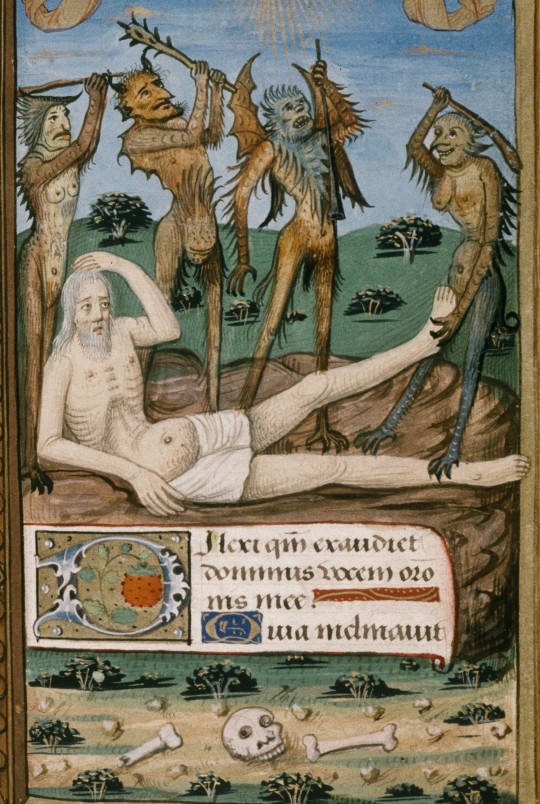
job on the dungheap, tormented by four demons
illustration from a book of hours, france (rouen), late 15th or early 16th c.
source: Oxford, Bodleian Library, MS. Buchanan e. 3, fol. 55r
#15th century#16th century#book of hours#job#job on the dungheap#book of job#demons#illuminated manuscript
262 notes
·
View notes
Text

The oldest known cello in the world is "The King" made by Italian instrument maker Andrea Amati (c. 1505 - 26 December 1577) around mid-16th century AD in Cremona, Italy.
It was part of a set of 38 stringed instruments made for the court of King Charles IV of France.
#King Charles IV of France#Andrea Amati#The King#cello#violin#stringed instruments#luthier#16th century#1500s
220 notes
·
View notes
Photo
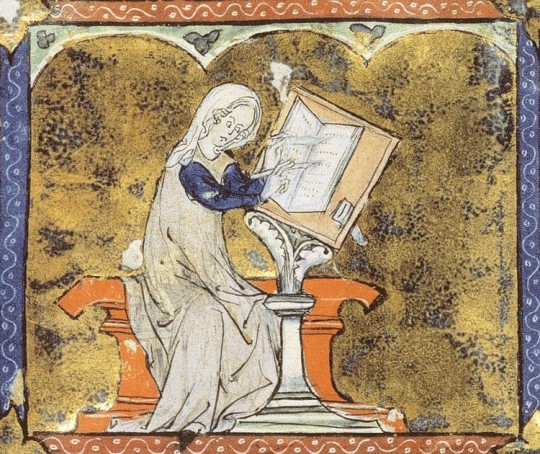
Marie de France
Marie de France (wrote c. 1160-1215 CE) was a multilingual poet and translator, the first female poet of France, and a highly influential literary voice of 12th-century CE Europe. She is credited with establishing the literary genre of chivalric literature (though this is contested), contributing to the development of the Arthurian Legend, and developing the Breton lais (a short poem) as an art form. Marie's published works include:
Lais (including the Arthurian works Chevrefueil and Lanval)
Aesop's Fables (a translation from Middle English to French) and other fables
St. Patrick's Purgatory (also known as The Legend of the Purgatory of St. Patrick)
She was trilingual, writing in the Francien (Parisian) dialect with a command of Latin and Middle English. Her lais were developed from the earlier Breton lais poetic form and so she must have also known Celtic Breton and been acquainted with Brittany. Her works influenced later poets, notably Geoffrey Chaucer, and her imagery in St. Patrick's Purgatory would be used by later writers in depictions of the Christian afterlife.
Marie's works were popular in aristocratic circles but frequently featured lower-class characters as more worthy and noble than their supposed social superiors and always cast women as strong central characters. Her vision of female equality has led to her designation as a proto-feminist in the modern day, and her works remain as popular as they were in her lifetime.
Identity
Her actual name is unknown – `Marie de France' is a pen name given her only in the 16th century CE. All that is known of her comes from her work in which she identifies herself as Marie from France. Based on details in her work including knowledge of place names and geography, and the sources she drew from, scholars have determined that Marie spent a significant amount of time in England at the court of Henry II (r. 1154-1189 CE) and his wife Eleanor of Aquitaine (l. c. 1122-1204 CE).
Scholars suggest Marie may have been Henry's half-sister who perhaps followed him from Normandy to England when he was crowned king in 1154 CE. The Lais of Marie de France are dedicated to “a noble king” who is most likely Henry II but precisely how Marie meant this dedication is unclear. Marie's poetry often features women imprisoned or otherwise poorly treated by men and this theme mirrors Henry's relationship with Eleanor.
Throughout their marriage, Henry was unfaithful to his wife numerous times and carried on an open affair with the noblewoman Rosamund Clifford. When Henry's sons rebelled in 1173-1174 CE with Eleanor's support, the king had her imprisoned for the next 16 years. This same sort of relationship, often with similar details, appears in a number of Marie's works. Further, Henry does not seem to have been as fond of poetry and poets as his wife was and so an interpretation of Marie's dedication as sarcastic is probable.
In modern-day scholarship, Marie is almost always credited with establishing the genre of chivalric literature, but this seems unlikely as her works clearly draw on a pre-existing tradition of courtly love literature whose central motifs she inverts. In courtly love poetry, the knight is seen rescuing the damsel in distress; in Marie's works, the knight is often the one who has imprisoned her in the first place or, sometimes, the one in need of rescue.
Continue reading...
47 notes
·
View notes
Text
Today's #YearOfHours is Lewis E 112, an early 16th c. Book of Hours written in France. It has a liturgical calendar for Lyon. It is generously illuminated, with twelve full-page miniatures, eighteen smaller miniatures, and illuminated initials.
🔗:
#medieval#renaissance#book of hours#year of hours#france#lyon#illuminated#illustrated#illuminated manuscript#book history#art history#rare books
36 notes
·
View notes
Text

✨Earthflown by Frances Wren
(releases on April 16th)
When Ethan saves the life of a firestarter, it's nothing unusual. He's the only healer on call at the hospital – and that gunshot wound isn't going to regenerate itself. But his patient turns out to be Corinna Arden, heiress to a pharmaceutical empire controlling Britain's water supply. Her twin, Javier, is a man who (a) starts sending Ethan flowers at work, (b) seems terrified of a secret, and (c) has the cheekbones and earnestness to make up for both.
Ethan indulges in (what he thinks will be) a brief, harmless romance – but is swept up in a deadly collusion over Project Earthflown: the largest reconstruction tender since London clawed its way out of the rising sea.
Determined to follow the money, Ollie is a journalist who finds a corpse at the end of a too-convenient tip. The fate of water - and who profits - might depend on the perennial question: Has Ethan lost his mind, or is he just an idiot?
--
Earthflown is a love story that tries – and fails – to leave the water crisis behind. Set in near-future, post-flood London, the novel takes a grounded approach to fantasy archetypes, where futuristic medicine meets a bit of magic. The Indigo exclusive edition with exclusive bonus scenes is available for preorder now !
You can already add the Book to your "want to read" shelf on goodreads or storygraph as well as browsing through it's very own website at earthflown.com
#Earthflown#Frances Wren#Litarnes#queer scifi#upcoming queer books#found family#hurt/comfort#climate fiction#asexual representation#own voices novel
15 notes
·
View notes
Note
What is the most ridiculously uselessly ornamented weapon/armor you have seen?
I'm actually going to give a bit of an out-of-universe answer for this one, because some historical armors are too crazy not to share! A few of my favourites:
In European ts important to distinguish "combat armor", which tended to be simple and to the point with "parade armor", which is not. Tournament armor, specialized for Hastilude events like jousting, was somewhere in the middle, with special reinforced areas. Here's a good example of how ridiculous it gets, with the 16th C. armor of King Henri II of France:


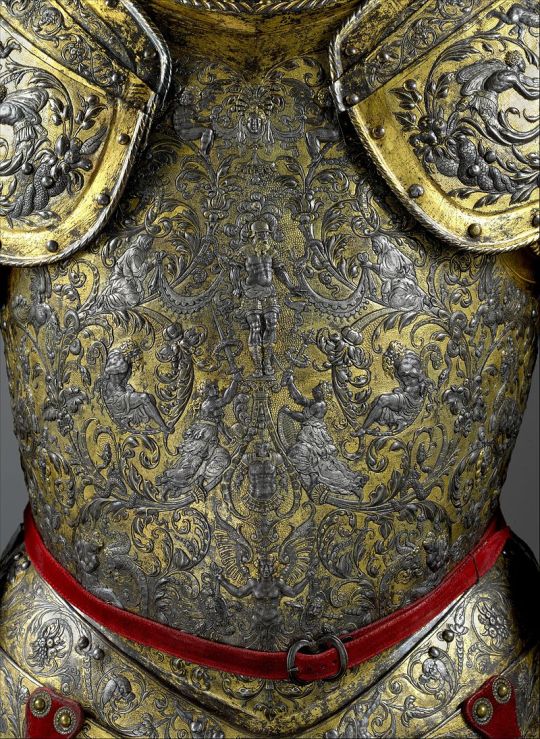

Spree killer King Erik XIV of Sweden shows that its not just Henri

Personally, I am fond of the masterwork "Greenwich Armor". In addition to its insane level of detail, its also blue. In a process called "Bluing" the steel is precisely oxidized to "dye" the armor a certain colour! So next time someone calls out your OC for heaving bright blue or red armor, these actually have some striking historical precedent!


I think the all-time winners though, are Iranian chain mail shirts. They often had intricate religious lettering on the rings, seen here using different metals...

While this one EVERY LINK is inscribed with a name of Allah or a short prayer!

And of course, no tour of insanely elaborate armor would be complete without checking in on our good friend and historical maniac Henry VIII of England, with his deranged "knight"mare fueled "Horned Helmet".
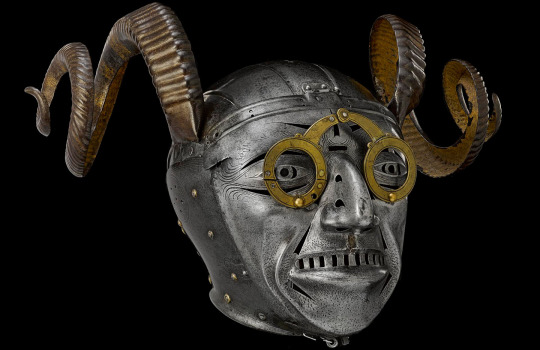
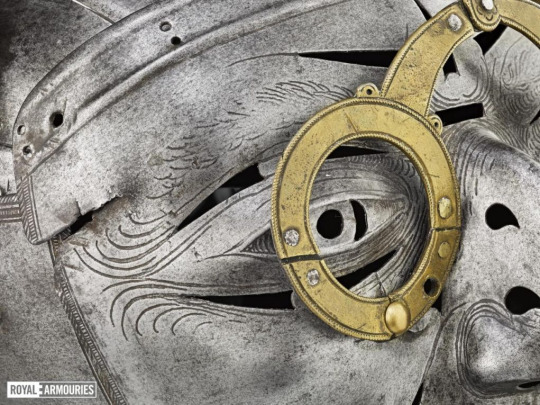
The historical armors of the world are pretty crazy, and the above are just a small selection of European and Near-Eastern varieties, not even touching on some of the equally insane armors from elsewhere, from the Japanese Kabuto (Ridiculously detailed and odd samurai helmets) to Chinese Paper Armor (Looks like a cosplay made out of post-it notes and office supplies) and the gorram amazing Kiribati Puffer Fish Armor, which looks like something out of a Flash Gordon comic. It is amazing and I wish more people would use it in their designs!

So, a little bit of a cop-out for not providing an Alvez specific answer, but unusual armor is a fascinating topic that far outshines anything I could come up with.
76 notes
·
View notes
Text
An exhaustive timeline of the Patron-Minette and their appearances in Les Misérables
Have you ever wanted to know the movements and actions of every single Patron-Minette character (including all affiliates?), throughout the narrative of Les Misérables and beyond? Well, this is the post for you!
This information is either collected from scenes that we as readers witness directly in Les Misérables, or pieced together (as best as I have been able to piece things together) from indirect snippets that Hugo gives us about these characters in passing. I haven’t listed the chapters where this information is located, but if you are curious feel free to message me and I can provide information!
P.S: There are many other wonderful Les Misérables timelines out there, which I urge you to check out! Please note that this timeline only contains information relating to the Patron-Minette, and that whilst Thénardier is featured multiple times in this timeline, he is not actually officially associated with the gang as an affiliate, but is rather a standalone crook that just happens to engage with the group in multiple scenes.
c.1793-1797;
Gueulemer likely born at some point in this period. In 1832 he is described as having ‘a mass of crow’s feet, though not yet forty years old’, and in 1815 he is working as a porter— so must have been an adult, or at least close to adulthood, in that year. Taken together, this information suggests that Gueulemer was probably born around within these years.
1811;
At La Force, Brujon’s father, who is also called Brujon, is locked up. He carves ‘BRUJON, 1811’ into the courtyard wall in the “Lion’s Den” at La Force.
[SPECULATIVE] Brujon is born. I suggest this only because of the line, ‘the Brujon or 1811 was the father of the Brujon of 1832’, which I feel implies Brujon must have been born around this time. Brujon is also described in 1832 as a ‘lad’, so must have been fairly young. If he was born in 1811, he would be 21 in 1832, which seems to align with the ‘lad’ description too.
c.1813-1814;
Montparnasse is born.
1815;
Gueulemer works as a porter in Avignon.
August 2nd
Gueulemer likely involved in the assassination of Marshal Brune.
Sometime before November, 1823;
Boulatruelle had been arrested and imprisoned for a crime we are not privy to, and likely was locked up on the Orion ship (since it is implied he recognised Valjean later in the novel).
He is released from prison and tries to find work in Montfermeil, but is unsuccessful. The only job he can get is for the administration, who hire him as a reduced-rate road mender. He is treated as an outcast by the people of Montfermeil.
1823;
‘Several days’ after November 16th
In Montfermeil, Boulatruelle continues his work as a road mender, but leaves his post early constantly to creep about in the forest. Thénardier, who still owned the inn at this time, gets Boulatruelle drunk in order to get him to reveal what he does in the forest. Boulatruelle reveals that he is trying to look for and dig up some treasure that he had seen an ex-convict whom he recognised (aka Valjean) hide in the woods. He is unsuccessful in finding this treasure.
Sometime before 1830;
Babet works a variety of jobs, including as a clown at Bobinos, and showing ‘freaks’ at fairs. During this time, he owns a booth with an advertisement that reads ‘Babet, dental artist, member of the academies, conducts physical experiments on metals and metalloids, extracts teeth, tackles stumps abandoned by his colleagues. Price: one tooth, one franc, fifty centimes; two teeth, two francs; three teeth, two francs, fifty. Take advantage of this opportunity.’
Babet gets married. He has children (it is not disclosed how many, but from the plural usage of ‘children’ rather than ‘a child’, we can assume he has more than one). The family travel together in his ‘booth-on-wheels’.
Babet’s wife and children disappear one day: ‘he had lost them the way you lose your hankie’. Soon after he decides to go and “tackle” Paris.
1830;
Patron-Minette begin ‘ruling’ the dregs of Paris.
Sometime between 1830-1832;
When out together one time, Courfeyrac points out Panchaud to Marius, seemingly aware of his reputation as a ‘dangerous night rambler’.
Montparnasse likely begins murdering people in this period as, by 1832, he already has ‘several corpses to his name’.
[SPECULATIVE] In this period Brujon had ‘done over’ a police station, out of sheer bravado. This information is revealed in a passing comment in the rue Plumet scene, which would mean that Brujon’s feat would have occured before June 1832, and, with Brujon being a fairly young ‘lad’, I am assuming that he would have only managed this feat in the last couple of years, after the Patron-Minette had begun to ‘rule’ the dregs of Paris.
1832;
We know that in 1832 the Patron-Minette has four heads, Babet, Gueulemer, Claquesous, and Montparnasse. We also know they have a vast network of associates - we learn 18 of their names; Panchaud*, Brujon*, Boulatruelle*, Laveuve, Homère Hugu, Mardisoir, Dépêche, Fauntleroy, Glorieux*, Barrecarrosse*, Lesplanade-du-Sud, Poussagrive, Carmagnolet, Kruideniers*, Mangedentelle, Les-pieds-en-l’air, and Demi-Liard*. [the affiliates who have an asterisk next to their name appear in the novel. The others sadly do not appear in any scenes].
February 2nd, evening
Brujon and Demi-Liard watch a melodrama at the Gaîté Theatre.
February 3rd, in the day
Thénardier converses with Panchaud near the rue de la Barrière-des-Gobelins, likely informing him of his plans for the Gorbeau ambush that evening. Marius sees them (and recognises Panchaud).
Later in the day, Brujon and Demi-Liard meet on the rue du Petit-Banquier, and Brujon convinces Demi-Liard to partake in the Gorbeau ambush that evening.
February 3rd, 6pm; the Gorbeau ambush
Babet, Claquesous and Gueulemer are present at the ambush.
Panchaud, Demi-Liard, Brujon, and Boulatruelle are present at the ambush.
Montparnasse is not present at the ambush. He shows up but stops on the boulevard outside the building to talk to Éponine, before they go off and ‘play Némorin’ together instead of help out on the job.
When Javert interrupts the ambush, all of the Patron-Minette characters present are arrested and taken to La Force. Azelma, Mme Thénardier, and Thénardier are also arrested. Thénardier is also sent to La Force along with the Patron-Minette, Mme Thénardier is sent to Saint Lazare, Azelma is sent to Les Madelonettes.
Night of February 3rd / morning of February 4th
Claquesous is ‘lost’ and manages to escape from the police’s clutches whilst being transported to La Force. He is free.
Éponine is found and ‘nabbed’, being sent to Les Madelonettes alongside her sister.
The Patron-Minette characters are all put into solitary at La Force.
Mid-February
Brujon released from solitary confinement and into Charlemagne yard, with the police hoping that he might reveal something whilst chatting. He spends his days in the yard staring at the canteen’s price list and complaining of being ill, shivering and trying to get sent to the infirmary. Secretly, he is plotting an escape.
The other arrested Patron-Minette characters remain in solitary.
‘Towards the end of February’
All captured Patron-Minette members remain in prison.
Brujon sends out notes to three previously unmentioned Patron-Minette associates, Kruideniers, Glorieux, and Barrecarosse [confirmed by the line ‘these men were somehow affiliated with the Patron-Minette gang], who patrol the areas of the Panthéon, the Val-de-Grâce’ and the barrière de la Grenelle respectively. These men are arrested by the police, who suspect that Brujon is planning a scheme from prison.
Brujon writes his note to Babet, informing him of rue Plumet. He is caught and sent to solitary for a month, but the note still gets to Babet.
Babet, using his mistress (locked up at La Salpêtrière) is able to transfer this note to Magnon, who delivers the note to Éponine as soon as she is released from Les Madelonettes.
Azelma and Éponine released from Les Madelonettes.
‘A few days later’; c. end of February / early March 1832
Éponine delivers a biscuit, meaning that there is nothing worth doing at rue Plumet, to Magnon, who transfers it to Babet’s mistress, who transfers it back to Babet.
‘Less than a week after that’; c. early March 1832
Babet and Brujon bump into each other, as one heads into the ‘preliminary’ and the other returns from it. Babet informs Brujon that there is nothing worthwhile at rue Plumet and the scheme is aborted.
March
Brujon is still spending his time in the correctional chamber, after being caught writing his note, and distributing notes outside of prison. Whilst there, he plans his escape, and makes a rope.
After being released from the correctional chamber, he is transported to the New Building. Here he finds Gueulemer and a nail.
One evening in early April
Beyond the Salpêtrière - in the Austerlitz area, Montparnasse follows Valjean with a rose in his mouth. He tries to attack the old man but is overpowered, and instead treated to a long lecture. Valjean hands Montparnasse his purse. Gavroche, who witnessed the whole thing whilst hiding in some shrubbery, then steals it from Montparnasse’s pocket and leaves it for Mabeuf.
The following day
Babet escapes prison in the morning, as he was being transported from La Force to La Conciergerie.
Gavroche bumps into Montparnasse at the corner of rue des Ballets, near La Force. Montparnasse tells Gavroche that he is off to find Babet and informs him that Babet has escaped (it is not clear how Montparnasse found out this information, or if he had seen Babet earlier that day, but regardless he still is aware of what happened). Montparnasse puts two quill pieces wrapped in cotton up his nose, disguising himself and making his voice sound different. He also carries his cane that contains a concealed knife within.
In the early hours of the next morning, ‘towards one o’clock’
Babet and Montparnasse meet up and prowl around La Force, waiting on Gueulemer and Brujon to escape. It is a windy, rainy night.
Brujon and Gueulemer get up in the middle of the night and start using the nail that Brujon had found before to break the chimney which their beds stood against. They scale the chimney, force the iron grating apart, and end up on the roof. They secure the rope that Brujon made to the iron railing and descent down the eighty foot drop down to the bathhouse, and exit onto the street, and regroup with Babet and Montparnasse. Brujon pulls the rope down, some of it tears and is left on the roof. This escape only takes 45 minutes.
Thénardier sees Brujon and Gueulemer escape on the roof from his cell.
One hour later, at around two o’clock
Thénardier drugs the conscript watching his cell with stupefying wine and steals his bayonet. He makes his way up to the roof (no further detail about how he made it onto the roof is given)
The remnants of Brujon’s rope left on the rood are far too short for Thénardier to use to escape. He is stranded there until 4am.
Two hours later, at four o’clock
The police are alerted of Thénardier’s escape. Babet, Montparnasse, Gueulemer, and Brujon congregate beneath the roof that Thénardier has been stuck above for the last couple of hours, arguing about whether they should leave him, or wait a little longer. They spot him once he throws down the remainder of the rope left on the roof at their feet. Montparnasse tells Brujon to tie the rope together again and throw it up, that way Thénardier can climb down. However, Thénardier is too cold to move. They determine they need a ‘nipper’. Montparnasse runs towards the Bastille.
‘Seven or eight minutes later’
Montparnasse returns with Gavroche, who helps Thénardier escape. Gavroche recognises him as his father, but Thénardier does not recognise Gavroche as his son, not even when Babet pulls him aside and informs him that the boy who saved him was his son.
June 3rd, in the morning
Brujon sees some sparrows fighting.
June 3rd, in the evening
Brujon encounters a woman arguing.
June 3rd, 1 hour after nightfall; rue Plumet attack
Babet, Gueulemer, Claquesous, Brujon, Montparnasse, (and Thénardier) show up to rue Plumet, carrying an array of various horrible weapons. Gueulemer is specified to be carrying a pair of fanchons. They encounter Éponine, who had not seen her father in four months.
Montparnasse and Éponine exchange awkwardly flirtatious dialogue, and she does not address him as Monsieur. She grabs his hand and he warns her that she’ll cut herself on his knife.
After failing to convince them that rue Plumet is a biscuit, Éponine leans against the gate and threatens to scream, before making her powerful (and devastatingly tragic) speech.
Babet reasons that there is something the matter with Éponine, and remains keen on doing the job. Montparnasse threatens her with a knife. Brujon however, who is described as a bit of an ‘oracle’, reveals that he is against entering the house now. He is superstitious, and recollects the fighting birds and woman he saw earlier in the day as a sign that the job was bad.
The gang resolves to clear out. As they leave, Montparnasse declares that he would have slit Éponine’s throat, if they would have wanted him to. Babet responds with ‘not me, I don’t touch women’.
June 5th, at night, but before ten o’clock
Le Cabuc**, a mysterious stranger, is at the barricades and drinking. He decides to try and get into one of the large houses along rue Saint-Denis, banging at the door. When he is denied entry, he shoots the porter. He is executed by Enjolras, and his body tossed into rue Mondétour.
**Early June, a short while after the barricades fell
In the morgue, Le Cabuc’s body is searched and a police agent’s card is found on his person. Victor Hugo (practically) confirms that Le Cabuc was Claquesous.
A special report on this subject is written for the Prefect of Police. Hugo claims that in 1848 he held this exact report.
‘Some little time’ after June 7th
Boulatruelle is released from prison, as there is not enough evidence to charge him for the Gorbeau ambush, since he was so drunk. He goes back to the road between Gagny and Lagny, where he used to work as a road mender before. His alcoholism becomes worse.
Soon after; ‘one morning, shortly before daybreak’
Boulatruelle spots a man walking in Montfermeil’s forests. He tries to follow him, but keeps losing sight. He eventually stumbles upon the location of the treasure he had so long dreamed of finding. But, the hole had been dug up, and it was empty.
c.1833;
Panchaud and Demi-Liard are sentenced to ten years in the galleys for their crimes during the Gorbeau ambush.
1835;
Patron-Minette stop ‘ruling’ the dregs of Paris. It is not clear whether that means the group disbanded or if they had simply become too weak and slipped from their position of power.
1843;
Panchaud makes a famous prison escape at La Force [unclear if the escape is successful]. We are informed that this escape happened in broad daylight, and involved thirty prisoners.
As Panchaud makes his escape, he writes his name above the culvert at the entrance to the sewer.
c.1848;
Panchaud has become a ‘celebrity crook’, and is spoken of as a legend by prisoners in La Force. (Hugo writes in 1862 that ‘he had a real following towards the close of the last reign’, which I believe is making reference to the reign of Louis Philippe - as the Second Republic did not have a king, but rather Presidents... but, I could most certainly be wrong!)
#patron minette#patron-minette#patron minette affiliates#babet#gueulemer#claquesous#montparnasse#brujon#panchaud#demi-liard#boulatruelle#glorieux#barrecarosse#kruideniers#les miserables#les mis#meta#timeline
40 notes
·
View notes
Photo

Leaf from a Book of Hours: Adam and Eve and the Fall of Man (Prefatory Miniature to the Office of the Virgin) (recto)
c. 1510
France, Rouen, 16th century
188 notes
·
View notes
Photo

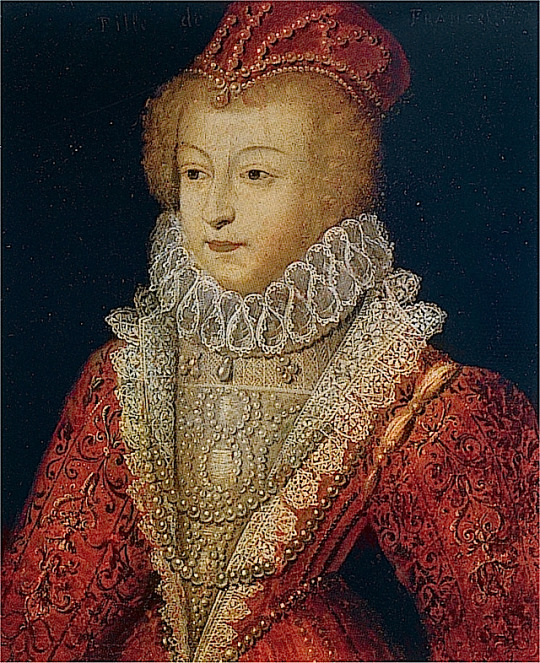
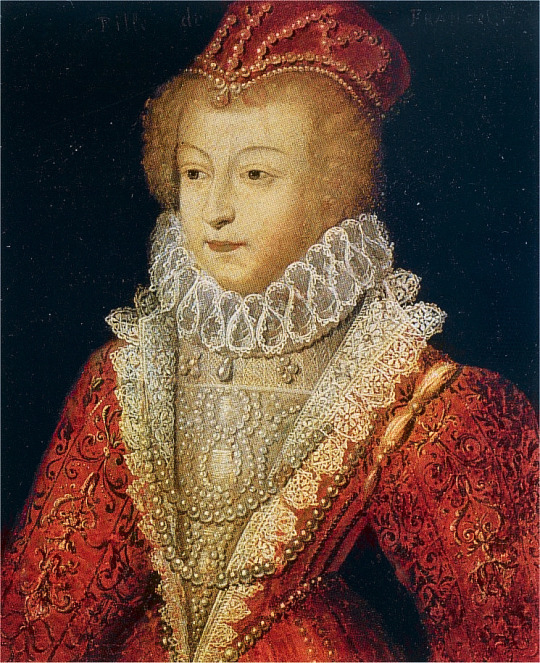
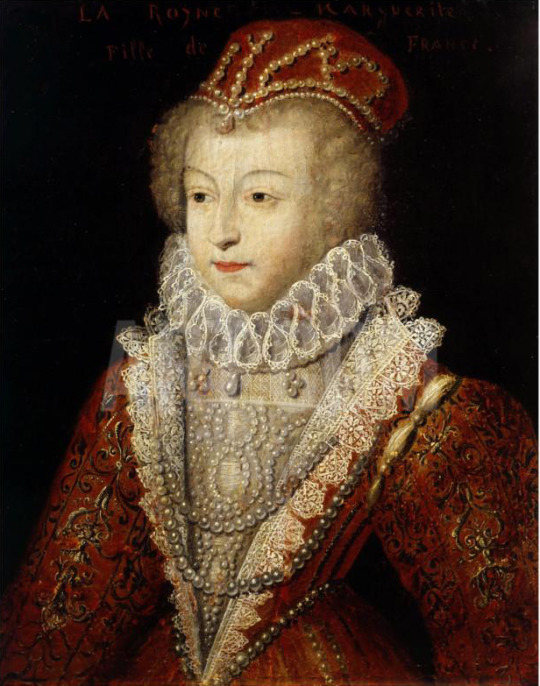

Marguerite de Valois by Francois Clouet, 1572
56 notes
·
View notes
Note
Hope this works : https://i.pinimg.com/564x/40/e6/eb/40e6eb52d24dee59e597ca00f46bcddd.jpg
Original ask:People keep saying this is Frances Brandon, but looking at the fashion and the features of the sitter, I feel it's Katherine of Aragon instead. What are your thoughts?
(we didnt have the photo originally, but now i can finally answer this).

-My first observation regarding this painting is that it cannot be Francis Brandon, because she was born in 1517. This is 1500s or 1510s fashion of Netherlands. No way she could be depicted in fashion which is from before she was even born!
On wikipedia it is labelled Portrait of Agniete van den Rijne, atributed to Joos van Cleve, located in Rijksmuseum Twenthe in Enschede, in Netherlands. And as being painted in 1st half of 16th century.
On webpage of the museum, it is labelled as Unknown woman in c.1515. I suspect it could be bit earlier(split gown, large hanging chains)-my guess would be late 1500s, max early 1510s. But my chronology of netherlandish fashion was based upon court fashion. And neckline this low is consistent with some parts of Habsburg Netherlands, but not the court. So I could be bit off. But either way-1500s or 1510s imo. Not Francis Brandon. She wasnt even born when this was in fashion.
As for Catherine of Aragon.
Not that she couldnt wear netherlandish fashion(Sittow's portrait)-but a)when she did wear it, it was same fashion as in court.
b) what cut photos deliberately left out, is that this painting has its original frame...which includes coat of arms.

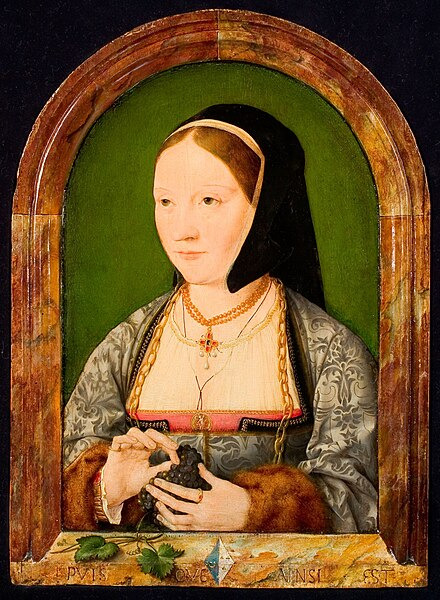
And experts believe this coat of arms to be original.

They havent been able to identify it nor of the man matching the woman. But clearly not Catherine's coat of arms.
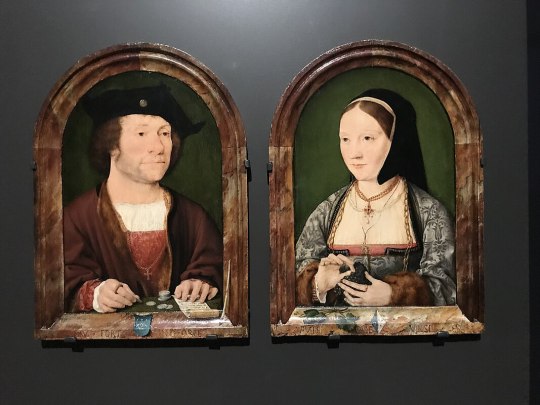
Also the focus here is on grapes-its fruit, its leaves and vines.
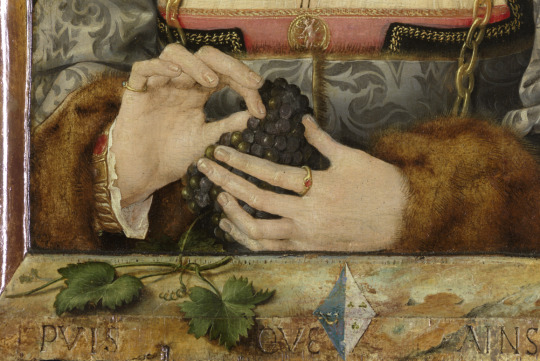
It is symbol of fertility and prosperity, as well as having several more meanings in christianity, but as far as i know never asociated with Catherine of Aragon specifically. And there is literally nothing to suggest it is her.
I agree that there is resemblence, but there is issue. The artist was skilled. So why upon closer inspection the nose looks so differently than hers?
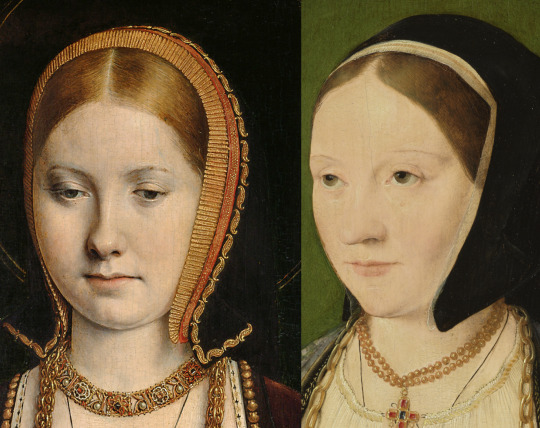
Catherine's nose tip seemed to be pointing more up and it was not as large. With some people-for example Margaret of Austria, size of nose changes as they age(due to health issues). However Catherine even in mid 1520s, still has narrow nose with tip basically same as in her youth.

Angle might play part a bit...but imo it is simply different nose.
The resemblence alone cannot drive identification. Not only do we not have single major clue pointing towards Catherine, we have major clue against her(coat of arms). Also Henry was likely painted by the artist when he met Francis I at Calais-with Anne Boleyn. The artist was asociated a lot with Francis, but never proven to travel to England or to take comissions from English royal court...aside that one meeting.
I am sorry, it is not Catherine of Aragon.
I am as upset as you guys that we don't have any surviving portrait of her from 1510s, and that many portraits we only know from not so great copies.
To find more lost originals, looking through art of artists which painted relatives of the person is indeed very good strategy. It pays off in many cases. Unfortuntely not in case of Joos van Cleve.
But it might be good idea to look up painters employed by Charles V and by Francis I in 1520-because Catherine met both that year.
Henry and Charles even had joined portraits made back then.

So there is indeed potential that some portrait of Catherine was created and it might have went with visitor. And it could have been another joined portrait because Charles didnt visit alone but with Germaine of Foix.
Problem is, the most likely thing for Catherine to wear in any portrait as Queen of England is gable hood- headwear unique to England. For her portraits to not be noticed, they would either have to be overpainted/altered, misidentified, misdated or even all three.
Another option is that upon meeting Charles that she wore spanish fashion. If she got painted in that, she wouldnt be that likely to be recognized.
Or maybe we need to broaden our idea of what Catherine wore.
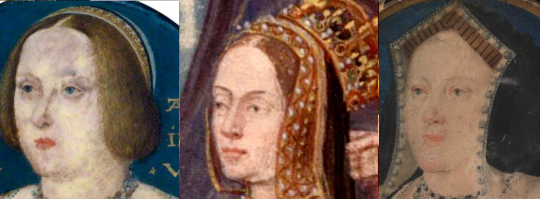
So my dears, the hunt is still on.
4 notes
·
View notes
Text


mermaids attacking a ship
in a manuscript of "la fleur de vertu", illuminated by the master of françois de rohan, france, early 16th c.
source: Paris, BnF, Français 1877, fol. 35r
#16th century#mermaids#hybrids#Le Maître de François de Rohan#la fleur de vertu#Fiore di virtù#sirens
316 notes
·
View notes
Text
Lecture Notes MON 16th OCT
Masterlist
BUY ME A COFFEE
Doing Art History: Drawing/Works on paper.
Oeuvre: the artworld of that time. The body of work by a painter, composer, or author.
Drawing was and has always been the first step into becoming an artist, it is the most fundamental and important aspect of any artistic study or development. To know your fundamentals, the figure, perspective, and weight/shading. Historically this is the first step any artist took, before developing into their preferred medium.
Observe these drawings/sketches and paintings; consider the materials, their effect and product.



Jean-Auguste-Dominique Ingres, Vicomtesse Othenin d'Haussonville, nee Louise Albertine de Broglie, study, ca. 1845, graphite, with white heightening, on paper, France, Musée de Carpentras.
Colourism – (not to be confused with the discrimination based on skin colour) Specifically in painting, it is a style of painting characterised by the use of intense colour, which becomes the dominant feature of the resultant work of art, mostly influential in the French impressionism movement of the 19th century.
Also: a person who uses colour in s particular way, draws attention to the colour use.

HILAIRE-GERMAIN-EDGAR DEGAS, WOMAN STANDING IN A BATHTUB C. 1890–92, charcoal with stumping on beige wove paper, 43.2 x 29.5 cm, Sterling and Francine Clark Institute

Edgar Degas
After the Bath, Woman Drying Herself, c. 1890-95
Pastel on wove paper laid on millboard. 103.5 x 98.5 cm. The National Gallery, London. Bought, 1959. Photo: © The National Gallery, London
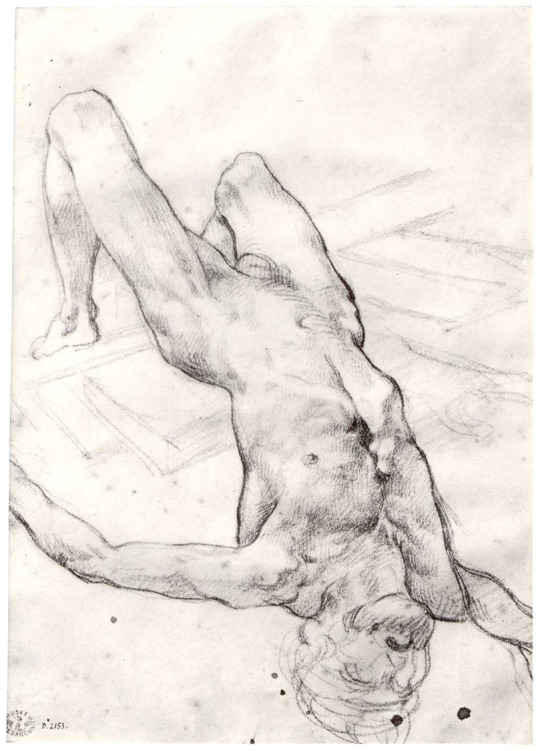
Théodore Géricault, Study for the Raft of Medusa, 1818, charcoal on paper, Paris, Musée du Louvre.
Observe the contour line (the darker outline line), surrounding the body. Note the twist and strain of the muscles and exaggeration of line and pose to create drama on the paper. Also note the materials used. Charcoal: a material that possesses a short life on paper without additives to preserve it. Something that smudges easily. Perhaps to quickly capture the body and idea and shading.
The Male nude – which surprisingly are the most common nude that exists in the western world. And this is because the basic fundaments were learnt from drawing casts, from the ancient world, or drawing from other works of art. Sketching development and a skill development, meant drawing bodies and getting to access to more complex forms to keep learning.
The RA is doing an exhibition on Impressionist on paper, which from the photos of artworks in this post, I recommend going to and seeing and judging for yourself, the use of materials and their effects.
On Degas and pastels: you can over saturate paper with pastels, muddying the colour. Critics of Degas spoke out, how his portrayal of bodies appear bruised. Degas was less interested in accuracy, more into the exploration of light on the body, the illumination, and the space it inhabits.
Genres of painting: Landscape, Portrait, Still life, Genre, Historical, Allegorical:
Allegorical paintings covered mythos. These were most prominent and popular when the state collected paintings, rather than when commissions came into prominence, and private ownership of painting rose.
Impasto: when paint stands off from the canvas. An Italian word for “mixture,” used to describe a painting technique wherein paint is thickly laid on a surface, so that brushstrokes or palette knife marks are visible. A pastose surface is one that is thickly painted.
19th century: paints in tubes begin to make an appearance.
Plain air: painting outside, open air painting. A common impressionist's expression.

Claude Monet
Cliffs at Etretat: The Needle Rock and Porte d’Aval, Pastel on wove paper, c. 1885. 39 x 23 cm. National Galleries of Scotland. Accepted in lieu of Inheritance Tax by H M Government from the estate of Miss Valerie Middleton and allocated to the Scottish National Gallery, 2016
Drawings always have a subjective idea of being ‘finished’ surrounding them. A rising problem surrounding the impressionist artists was critics perceptions of the artworks seeming unfinished, which could decrease a value of an artwork.

Berthe Morisot, At the Beach in Nice, 1882, pencil and watercolour, Stockholm, Nationalmuseum.
Note the signing of this particular artwork, in the bottom left corner. A tendency that arose after an artist died and their work became more famous or popular, their families would sign the work in their name.
Moreover, looking at this artwork it may surprise some to know that watercolour is considered a less prestigious material to use. As opposed to oil painting, which carries a greater prestige due to its difficulty to use and master. Leaving less room for imperfections. As a snide response to the impressionist movement, critics suggested that these artist under this movement, stick to and use watercolour.
Consider critics opinions of materials and how that translates to accessibility and intension.
Watercolour is actual a far more accessible material than oil painting and can give you a great finish, especially for artists that were painting on open air and their surroundings live.
#art#artwork#writing#essay#paintings#art tag#art hitory#art exhibition#art show#art gallery#lecture#essay writing#writers#creative writing#writeblr#writers on tumblr#writers and poets#education#learn#teaching#learning#students#educators#artists#artists on tumblr#drawings#illustration#art style#history#histoire
7 notes
·
View notes
Text
I’ve been down a rabbit hole wondering about medieval jewelry (and if I can reproduce it despite having no metalworking skills, to which the answer is mostly no) lately & I figured I would share the fruits of my museum collection searches for other medievalists/hobbyists/reenactors/nerds.
Jewelry of the 13th Century Anglo/Francosphere

TL;DR
Metals: 🟨 gold(tone)
Stones: mostly 🔵 cabochon, rarely 💠 simple cut, some carved 🗿 intaglio or cameo
Stone Colors: warm blues, emerald green, purples, burgundies, reds
Materials: enamel, 💎 gemstones (garnet, Ceylon sapphire, ruby/spinel, emerald) or glass paste imitations, ⚪ semi-precious stones (pearl, lapis, jasper, carnelian, coral, turquoise, porphyry)
Settings: bezel (oval and rectangular); ⚜️ intricate metalwork; more visible and textured metal than modern jewelry; more mixtures of stones and colors than modern tastes
Motifs: ◯ round, ✤ quatrefoil, ✙ cross, ✸ star (even numbers of points), ♣ trefoil, ❦ floral, 🐉 animals, 𝕬 inscription
Formats: brooches, ornamented clothing, rings, pendants, circlets, cuffs (rare)
A detailed look:
Some forms of jewelry that were very popular in the Roman Empire and are again today were just not the thing in the middle European Middle Ages. (Earrings, for example, seem to have barely existed. This is partially at least because ears were covered--by coifs and caps, hair, and (for women) braids or the chin strap and fillet/wimple/gorget.) In fact, a lot of the places we would put jewelry against our skin today were covered.
This left some other options:
Jewelry on Clothing
Medallions
Okay, these aren’t jewelry, strictly speaking, but they’re metalwork ornaments associated with a person.
Enamel Mitre Medallions


OA 3437 and OA 3438
Before 1291, Ile de France
Louvre, Paris
photos (c) Musée du Louvre / Stéphane Maréchalle 2015
Cloisonné and plique enamel over gold and copper, with decorative motifs of trefoils, quatrefoil, and stars in a palette of dark blue and green with accents that may once have been ruby red.
Appliqué Medallion
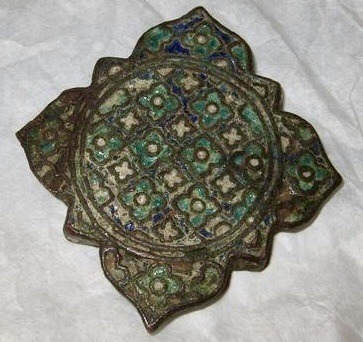
# MRR 256
13th c., Limoge
Louvre, Paris
photo (c) Musée du Louvre 2014
Gilded copper (though most gold is worn off) with quatrefoil champlevé enamel in emerald green, lapis blue, and white or off-white.
Brooches
Perhaps the most prevalent medieval jewelry item in the Anglo & French regions. These were worn at the shoulder for men and breast for women, often anchoring a cloak, or to close the collar. As the ornate fermail and double-ring brooch suggest, these ran the gamut from practical to incredibly decorative and ornate.
Garnet & Silver Gilt Animal Ring Brooch; Green and Blue Glass and Gilt Ring Brooch


Left, # 2003,0703.1
13th century; found in Suffolk, England
British Museum, London
photo (c) The Trustees of the British Museum
Right, # M.28-1929
13th c., England
V&A, London
photo © Victoria and Albert Museum, London
Cabochon garnets or carbuncles in the gilded silver brooch (L), perhaps once paired with smaller stones in the eyes of metalwork animals that bite the pin bracket. The right brooch, also silver gilt, sports two glass paste emerald and sapphire "gems" in cabochon. It was probably a lover's token; it reads (in Lombardic-lettered French) IOSV ICI ATI VCI or "jo su[i] ici a t[o]i v[o]ici" which I might translate as "I am here with/belonging to you, look!"
Ruby & Sapphire Ring Brooch; Sapphire, Garnet, and Pearl Fermail
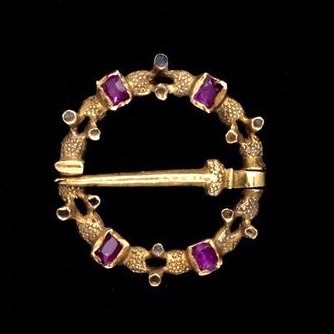
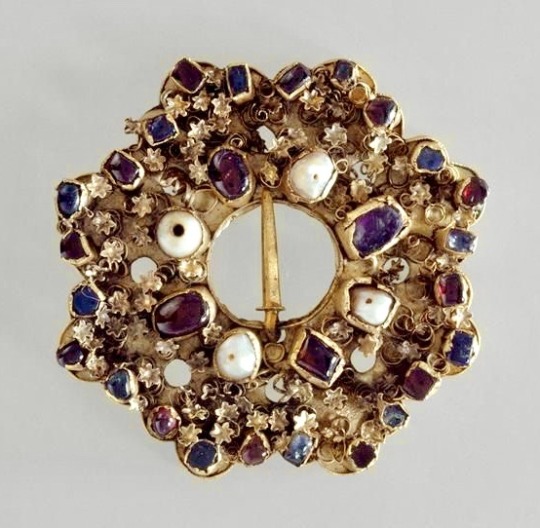
Left, # 6808-1860
1275-1300, England
V&A, London
photo © Victoria and Albert Museum, London
Right, # OA6287
1250-1300, France
Louvre, Paris
photo (c) Musée du Louvre
Blogs often claim that stones were only polished en cabochon until the 16th century, and that medieval jewelers couldn't cut gemstones. But this 13th-century gold ring brooch (left) pairs table-cut purple rubies with collet-set cabochon sapphires, and may evidence early medieval gem-cutting or reuse of Roman cut stones. The silver gilt fermail, right, includes pearl beads, garnets and sapphires both cut and cabbed, and one glass paste cabochon. Both are intricately textured, with punchwork (L) and floral metalwork, probably cast and then attached (R).
Double Ring Brooch with Sapphire and Glass "Emeralds"
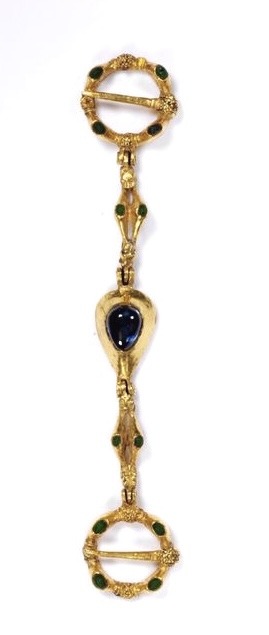
# M.26-1993
13th c., England
V&A, London
photo © Victoria and Albert Museum, London
This gold double brooch is so small they think it was for a woman or child. Central sapphire cab is flanked by glass paste "emeralds" in bezel settings and metalwork featuring two animal heads.
Jewelry on the Body
Rings
Many are probably familiar with the signet ring, used for pressing into sealing wax, which could be intaglio-carved gemstone or metals. There were also a number of decorative and/or talismanic gemstone rings.


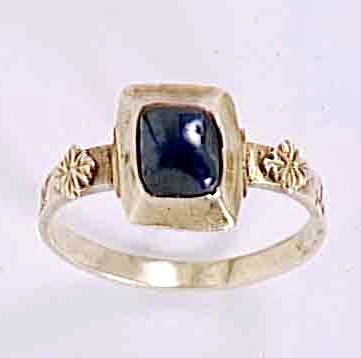
LtR:
#M.7-1929 | #M.180-1975 | #OA 11265
1250-1300, England | 1250-1300, Engl/France | 13th c., Engl/France
V&A, London | V&A, London | Louvre, France
photos L&C © Victoria and Albert Museum, London | R (c) Musée du Louvre
Sapphire in gold is the name of the game when it comes to rings in the thirteenth century; even the purple stones on the left are purple sapphires. (Sapphires were said to aid chastity, purity, and the effectiveness of prayer.) For larger stones, the bezel often has claws added (L); the central ring is an example of a full claw setting that modern viewers might find surprisingly tall. Naturalistic flourishes are added (C & R); these might be pre-cast then attached to the base (R).
Pendants
We equate pendants with necklaces, but their medieval applications also included wear as badges, from headpieces, and on horse decorations.


Left, bloodstone jasper cameo in silver setting
# MRR 218
1100-1300, France?
Louvre, Paris
photo (c) Musée du Louvre / Jean Blot 1984
Right, champlevé enamel, gilt copper, and paste "emerald" (harness) pendant
# 1976.169
13th c., France
Cleveland Museum of Art, Cleveland
photo CC0 Open Access
Statue Jewelry
From here, we get into the really ridiculous stuff; the previous categories could be relatively everyday (as much as ornamentation reserved exclusively for the wealthy can be an everyday thing) but the following examples are astonishing displays not necessarily for wear.
"La Couronne" de Vierge et l'Enfant d'ivoire de la Sainte-Chapelle

# OA 57 B
1250-1300, France
Louvre, Paris
photo (c) Musée de Louvre
This was not even a crown for a person, but rather for a painted ivory statue of the Virgin Mary, holding her infant son. (Though circlets, even set with stones, were sometimes worn as part of women's head dress.) It's incredibly ornate gold, set with pearls, garnets and rubies, sapphires, and turquoise (?) en cabochon.
Anneau de Saint-Denis




# MS 85 BIS
1200-1215, France
Louvre, Paris
photos (c) Musée du Louvre / Daniel Arnaudet 1990
This astonishing piece, which is ring-sized but now displayed as a cuff on an ivory hand, is made of gold and displays every possible gemstone appearance characteristic of the period. The front piece has a central sapphire and is surrounded by quartz with red backing (mimicking ruby/garnet), amethysts, pearls, and sapphires, some set on yellow backing (mimicking turquoise?). Most are en cabochon on this face, but two are faceted and two intaglio. Were this not enough, the three other 'faces' of the ring are set with gems as well, two cameos (probably sapphire and garnet?) and one amethyst intaglio set in ornate gold filigree.
#medieval#jewelry making#lapidary#history of fashion#historical jewelry#1200s#reenactment#England#France#enamel jewelry#ring brooch#fermail#intaglio#cameo#gemstones#infodumping#now time to go to the bead store#material history#you would think this is for my research or academically relevant but it's not I just couldn't stop looking at shiny things help#photos not mine#photos for educational purposes and not for commercial reproduction#louvre#v&a museum#british museum#cleveland museum of art
34 notes
·
View notes
Text
CPom on Polina Edmunds's podcast - pt 1
Christina's mom was a skating coach when she was little - put her in skates at age 3, loved it right away. Anthony's parents didn't want him to skate originally, Polina's mom convinced them, said he was like a wind up toy as soon as his feet hit the ice and loved it. Both moved to Michigan separately at 13, then teamed up shortly after
Christina started ice dance at 6 or 7 - loved the dresses. jumping wasn't her thing. Anthony drawn to the storytelling. Anthony's parents coached him with his previous partner til he moved to Igor - at 12/13 he wasn't listening to his parents any more, so they thought going to a more professional environment would be good for him and sent him alone to Michigan
Teamed in 2014, been almost 10 years - Christina: everything just clicks, can't imagine skating with anyone else. Anthony- both left home early, relied on each other through ups and downs. A lot of history - can't imagine doing this with anyone else.
Careers in ice dance are long [compared to singles]- C: you have to consistently deliver good programs and stay in shape for so long. people at the top make it look easy, but it's a lot of work. [we] take it one year at a time. A: this is our 6th season in seniors, we're still pretty new compared to teams who are in their 12th, 14th, 16th seasons. continuing to grow and work on ourselves. longevity is key. make sure we're not injured.
Switching from Igor to Scott:
C: many reasons why we decided it was best to leave - wanted a new approach to skating, new maturity, needed new people to bring a different energy. we've never looked back and thought maybe we should have stayed. we're really really happy with where we are now. it's such a healthy training environment and so positive all the time, and it really inspires us to bring the best versions of ourselves to the rink every day. feels very authentic and where we're supposed to be
A: because like you said Polina, we spent most of our 10 years with Igor, the transition was pretty hard on us. and only now 2 years with Scott, I'm looking back like this was the best decision we ever made.
The energy he and Madison and Adrian bring is amazing. It's unbelievable the amount of passion they have for the sport. What they create together is beautiful, and also being part of IAM and having the coaches in Montreal helping us out. and we had the great opportunity to choreograph with Marie-France for our Summertime program - having all that together this is the best decision we've ever made.
19 notes
·
View notes